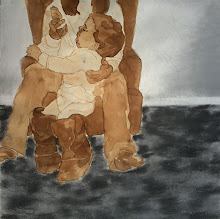As far as my weaknesses are concerned, I am aware that I, from time to time, place an excessive amount of lines on the paper. The root of this is a feeling that the drawing isn’t going very well and that more lines can resolve the issue. This action results in the person looking older than they actually are or at the very worst an unintelligible tangle of heavy marks. I guard myself from this way of thinking now, and try to not be reactive. Rather, I try to keep my mind a step ahead of my hand and impulsive line making in check.
Example of an unintelligible tangle
Example of a more restrained approach
My strength is mostly my fluid mark making. There has been progress with proportions and muscle attachments but I’m not sure they are yet strengths of mine. I have often been told that my fluid line quality is distinct. I believe this to be true, and find it to be quite an enjoyable way to draw. Lines that an artist puts down can be a documentation of his or her own body in time. Pressure, speed and grace are all evident through line weight, length, orientation, and association with other lines. It feels like dancing. This approach not only breathes life into the drawn subject but also into the artist.
As I stated earlier, I believe I made progress in the areas of proportion and locations of muscle attachments. This is probably the most important knowledge I could take from the course. Also, the shape of the muscle bellies is another bit of knowledge that has benefited my drawings greatly. A common theme in my artwork is family photographs. Knowledge of bone, muscles, and typical plane changes will help me make a drawing from a photograph more life-like. Regardless, the human figure appears in most of my work so I see figure drawing sessions as essential practice.
Portfolio since midtermz: http://www.flickr.com/photos/fridgedoor/sets/72157622917583247/



No comments:
Post a Comment